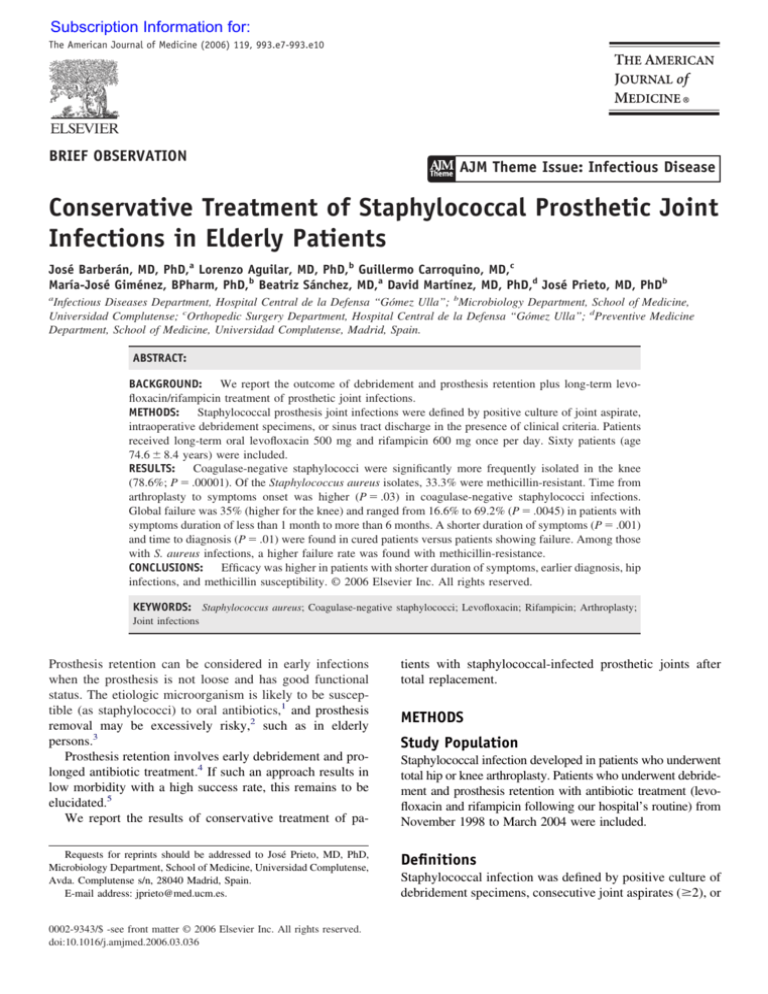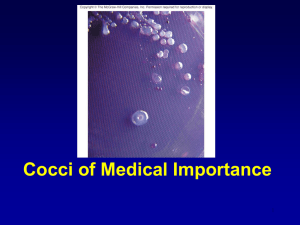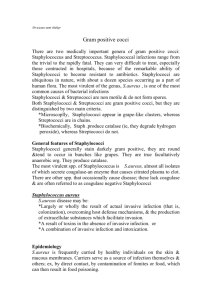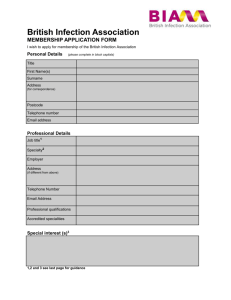
Subscription Information for:
The American Journal of Medicine (2006) 119, 993.e7-993.e10
BRIEF OBSERVATION
AJM Theme Issue: Infectious Disease
Conservative Treatment of Staphylococcal Prosthetic Joint
Infections in Elderly Patients
José Barberán, MD, PhD,a Lorenzo Aguilar, MD, PhD,b Guillermo Carroquino, MD,c
María-José Giménez, BPharm, PhD,b Beatriz Sánchez, MD,a David Martínez, MD, PhD,d José Prieto, MD, PhDb
a
Infectious Diseases Department, Hospital Central de la Defensa “Gómez Ulla”; bMicrobiology Department, School of Medicine,
Universidad Complutense; cOrthopedic Surgery Department, Hospital Central de la Defensa “Gómez Ulla”; dPreventive Medicine
Department, School of Medicine, Universidad Complutense, Madrid, Spain.
ABSTRACT:
BACKGROUND: We report the outcome of debridement and prosthesis retention plus long-term levofloxacin/rifampicin treatment of prosthetic joint infections.
METHODS: Staphylococcal prosthesis joint infections were defined by positive culture of joint aspirate,
intraoperative debridement specimens, or sinus tract discharge in the presence of clinical criteria. Patients
received long-term oral levofloxacin 500 mg and rifampicin 600 mg once per day. Sixty patients (age
74.6 ⫾ 8.4 years) were included.
RESULTS: Coagulase-negative staphylococci were significantly more frequently isolated in the knee
(78.6%; P ⫽ .00001). Of the Staphylococcus aureus isolates, 33.3% were methicillin-resistant. Time from
arthroplasty to symptoms onset was higher (P ⫽ .03) in coagulase-negative staphylococci infections.
Global failure was 35% (higher for the knee) and ranged from 16.6% to 69.2% (P ⫽ .0045) in patients with
symptoms duration of less than 1 month to more than 6 months. A shorter duration of symptoms (P ⫽ .001)
and time to diagnosis (P ⫽ .01) were found in cured patients versus patients showing failure. Among those
with S. aureus infections, a higher failure rate was found with methicillin-resistance.
CONCLUSIONS: Efficacy was higher in patients with shorter duration of symptoms, earlier diagnosis, hip
infections, and methicillin susceptibility. © 2006 Elsevier Inc. All rights reserved.
KEYWORDS: Staphylococcus aureus; Coagulase-negative staphylococci; Levofloxacin; Rifampicin; Arthroplasty;
Joint infections
Prosthesis retention can be considered in early infections
when the prosthesis is not loose and has good functional
status. The etiologic microorganism is likely to be susceptible (as staphylococci) to oral antibiotics,1 and prosthesis
removal may be excessively risky,2 such as in elderly
persons.3
Prosthesis retention involves early debridement and prolonged antibiotic treatment.4 If such an approach results in
low morbidity with a high success rate, this remains to be
elucidated.5
We report the results of conservative treatment of pa-
tients with staphylococcal-infected prosthetic joints after
total replacement.
Requests for reprints should be addressed to José Prieto, MD, PhD,
Microbiology Department, School of Medicine, Universidad Complutense,
Avda. Complutense s/n, 28040 Madrid, Spain.
E-mail address: jprieto@med.ucm.es.
Definitions
0002-9343/$ -see front matter © 2006 Elsevier Inc. All rights reserved.
doi:10.1016/j.amjmed.2006.03.036
METHODS
Study Population
Staphylococcal infection developed in patients who underwent
total hip or knee arthroplasty. Patients who underwent debridement and prosthesis retention with antibiotic treatment (levofloxacin and rifampicin following our hospital’s routine) from
November 1998 to March 2004 were included.
Staphylococcal infection was defined by positive culture of
debridement specimens, consecutive joint aspirates (ⱖ2), or
993.e8
The American Journal of Medicine, Vol 119, No 11, November 2006
sinus tract discharge (ⱖ3 on different days). At least one of
were rheumatoid arthritis (10 cases), type II diabetes melthe following criteria should be present: local pain, swelllitus (7 cases), and mild renal failure (4 cases).
ing, C-reactive protein greater than 0.6 mg/dL, and/or erythTwenty-eight infections (46.7%) followed knee arthrorocyte sedimentation rate greater than 10 mm in the first
plasty, and 32 infections (53.3%) followed hip arthroplasty.
hour; radiolucent areas at bone-cement interface, periprosOne year was the minimum follow-up period posttreatment.
thetic osteolysis or localized periSymptoms duration of less than
osteal new bone formation in ra1 month was reported by 24 padiography, and/or bone scanning
tients (40%), 2 to 6 months by 23
CLINICAL SIGNIFICANCE
positive,
C-reactive
protein
patients (38.3%), and more than 6
greater than 0.6 mg/dL, and/or
months by 13 patients (21.7%).
● Coagulase-negative staphylococci are
erythrocyte sedimentation rate
more frequent etiologic agents of prosgreater than 10 mm in the first
Microbiologic Findings
thetic knee joint infections than coaguhour (these determinations were
Etiologic diagnosis was perlase-positive staphylococci.
not considered if performed 2
formed by culture of aspiration
weeks after the arthroplasty); and
● Unacceptable failure rates of conservasamples (19 cases; 31.7%), dea sinus tract communicating with
tive treatment were found in patients
bridement material (34 cases;
the prosthesis.
56.7%), and sinus tract discharge
with long symptomatic time periods be“Treatment success” was de(7 cases; 11.7%: 0/24 [0%] for
fore diagnosis.
fined as the resolution of all signs
symptoms duration of ⬍ 1 month,
● Time free of symptoms (from joint reand symptoms of active infection
4/23 [17.4%] for 2 to 6 months,
placement to symptoms onset) was twice
without prosthesis removal at the
and 3/13 [23.1%] for ⬎6 months).
end of therapy and at the end of
as long for coagulase-negative staphyloStaphylococcus aureus was isoeach patient’s follow-up. “Treatcocci than for Staphylococcus aureus.
lated in 21 cases (35%), and coagment failure” was defined as the
ulase-negative staphylococci was
● Methicillin-resistance showed a tenlack of response to therapy or reisolated in 39 cases (65%). All codency for treatment failure of S. aureus
currence of signs and symptoms
agulase-negative staphylococci but
prosthetic joint infections.
and/or sinus tract bacterial isolatwo (S. haemolyticus, S. warneri)
tion during therapy or follow-up.
were S. epidermidis. All isolates
“Time free of symptoms” was
were levofloxacin-susceptible.
defined as time (in months) from
Table 1 shows etiologic and anatomic relationships. In
joint replacement to symptoms onset; “symptoms duration”
the etiologic relationship, S. aureus was more (P ⫽ .039)
was defined as time (in months) from initiation of symptoms
prevalent in hip infections (15/21; 71.4%).
to diagnosis; and “time to diagnosis” was defined as time (in
From the anatomic perspective, S. aureus and coagulasemonths) from joint replacement to diagnosis, and was the
negative staphylococci accounted for approximately oneaddition of both.
half each of all hip infections, whereas coagulase-negative
staphylococci were the causative agents in 78.6% of knee
Antibiotic Treatment
joint infections (22/28), and S. aureus was the causative
Patients received oral levofloxacin 500 mg and rifampicin
agent in 21.4% of knee joint infections (6/28) (P ⫽ .00001).
600 mg once per day for at least 6 weeks after resolution of
No differences were found in S. aureus isolation among
signs and symptoms, and normalization of C-reactive prothe three categories of symptoms duration: 37.5% for less
tein for a minimum of 3 months. This treatment was initially
than 1 month, 26.1% for 2 to 6 months, and 46.2% for more
prescribed or followed an initial short course (⬍2 weeks) of
than 6 months.
intravenous levofloxacin (500 mg once per day) plus oral
rifampin 600 mg once per day.
Statistical Analysis
The chi-square test was used for comparisons of percentages. The mean time values were compared using the paired
Student t test or the Mann-Whitney U test. A P value less
than .05 was considered significant.
RESULTS
Study Population
Sixty patients (mean age: 74.6 ⫾ 8.4 years) were included,
38 of whom were female (63.3%). Underlying diseases
Table 1 Prosthetic Joint Infections by Microorganism and
Anatomic Site
Knee
Hip
Staphylococcus
aureus
Coagulasenegative
Staphylococci
Total
n
%
n
%
n
%
6
15
21.4
46.9*
22
17
78.6†
53.1
28
32
100
100
*P ⬍ .05 vs knee.
†P ⬍ .05 vs S. aureus.
Barberán et al
Table 2
Prosthetic Joint Infections Conservative Treatment
993.e9
Treatment Failure Rates for Prosthetic Joint Infections by Anatomic Site, Microorganism, and Duration of Symptoms
No. Failures/No. Patients (%)
Staphylococcus aureus
Duration Knee
ⱕ1 mo
2-6 mo
⬎6 mo
Total
Hip
Total
Coagulase-negative Staphylococci
Total
Knee
Knee
Hip
Total
Hip
Total
1/4 (25)
0/5
1/9 (11.1) 1/7 (14.2) 2/8 (25.0) 3/15 (20.0) 2/11 (18.2) 2/13 (15.4) 4/24 (16.6)
1/1 (100)
2/5 (40.0) 3/6 (50.0) 4/9 (44.4) 1/8 (12.5) 5/17 (29.4) 5/10 (50.0) 3/13 (23.1) 8/23 (34.8)
1/1 (100)
3/5 (60.0) 4/6 (66.6) 4/6 (66.6) 1/1 (100)
5/7 (71.4)
5/7 (71.4) 4/6 (66.6) 9/13 (69.2)*
3/6 (50.0) 5/15 (33.3) 8/21 (38.1) 9/22 (40.9) 4/17 (23.5) 13/39 (33.3) 12/28 (42.8) 9/32 (28.1) 21/60 (35.0)
*P ⬍ .05 vs ⱕ 1 month.
Seven of 21 S. aureus infections (33.3%) were methicillin-resistant Staphylococcus aureus (MRSA).
Among S. aureus infections, MRSA isolates increased as
symptoms duration increased, from 11.1% (1/9) when less
than 1 month, to 33.3% (2/6) when 2 to 6 months, and
66.6% (4/6) when more than 6 months, although differences
between less than 1 month and more than 6 months of
symptoms duration were not significant (P ⫽ .09).
Treatment Outcome
Table 2 shows failure rates according to symptoms duration.
Differences (P ⫽ .0045) were found in the failure rate between patients with more than 6 months of symptoms duration (69.2%) and patients with less than 1 month of symptoms duration (16.6%). Differences between these two
groups were maintained splitting by hip (66.6% for ⬎6
months vs 15.4% for ⬍1 month; P ⫽ .088) or knee infections (71.4% for ⬎6 months vs 18.2% for ⬍1 month;
P ⫽ .077). Globally, similar failure rates were obtained in S.
aureus versus coagulase-negative staphylococci infections
(38.1% vs 33.3%), but not (P ⫽ .23) in knee versus hip
infections (42.8% vs 28.1%).
Among those with S. aureus infections, more failures
(P ⫽ .08) were obtained for MRSA (5/7; 71.4%) than for
methicillin-susceptible isolates (3/14; 21.4%).
Timings and Outcome
Longer times were found in patients showing failure: longer
time free of symptoms (2.0 ⫾ 1.8 vs 1.1 ⫾ 0.9; P ⫽ .09),
longer symptoms duration (6.7 ⫾ 4.3 vs 2.5 ⫾ 2.4;
P ⫽ .001), and longer time to diagnosis (7.3 ⫾ 4.8 vs
3.5 ⫾ 2.9; P ⫽ .01).
Timings in Relation to Cause
Table 3 shows these data split by cause. Differences in
time free of symptoms between patients showing failure
and cure were the result of those infected by coagulasenegative staphylococci (2.6 vs 1.3; P ⫽ .062), because
time free of symptoms was similar (regardless outcome)
in the case of S. aureus infections (0.8 vs 0.9; P ⫽ .83).
Significantly longer symptoms duration was found in
patients with failures for both S. aureus (7.4 vs 2.7;
P ⫽ .034) and coagulase-negative staphylococci (6.2 vs
2.5; P ⫽ .012), whereas longer time to diagnosis was only
found in coagulase-negative staphylococci (8.2 vs 3.4;
P ⫽ .018).
As shown in Table 3, time free of symptoms (considering
all infections regardless outcome) was twice as long for
coagulase-negative staphylococci than for S. aureus (1.8 vs
0.9; P ⫽ .03).
Table 3 Treatment Outcomes in Prosthetic Joint Infection According to Cause, Time Free of Symptoms, Symptoms Duration, and
Time to Diagnosis
Time (Months)
n
Time Free of Symptoms
Symptoms Duration
Time to Diagnosis
Staphylococcus aureus
Cure
Failure
Total
13
8
21
0.9 ⫾ 1.3
0.8 ⫾ 0.4
0.9 ⫾ 1.1
2.7 ⫾ 2.9
7.4 ⫾ 4.5†
4.5 ⫾ 4.2
3.6 ⫾ 4.1
5.4 ⫾ 3.4
4.1 ⫾ 3.9
Coagulase-negative staphylococci
Cure
Failure
Total
26
13
39
1.3 ⫾ 0.7
2.6 ⫾ 1.9
1.7 ⫾ 1.4*
2.5 ⫾ 2.2
6.2 ⫾ 4.5†
3.8 ⫾ 3.6
3.4 ⫾ 1.9
8.2 ⫾ 5.2†
5.0 ⫾ 4.0
*P ⬍ .05 vs S. aureus.
†P ⬍ .05 vs cure.
993.e10
The American Journal of Medicine, Vol 119, No 11, November 2006
Table 4 Treatment Outcomes in Prosthetic Joint Infection According to Infection Site, Time Free of Symptoms, Symptoms
Duration, and Time to Diagnosis
Time (Months)
n
Time Free of Symptoms
Symptoms Duration
Time to Diagnosis
Knee
Cure
Failure
Total
16
12
28
1.0 ⫾ 0.7
2.2 ⫾ 2.2
1.5 ⫾ 1.6
2.6 ⫾ 2.7
6.6 ⫾ 4.3*
4.4 ⫾ 4.0
3.1 ⫾ 2.5
8.3 ⫾ 5.7*
5.2 ⫾ 4.8
Hip
Cure
Failure
Total
23
9
32
1.3 ⫾ 1.1
1.7 ⫾ 0.8
1.4 ⫾ 1.1
2.5 ⫾ 2.3
6.8 ⫾ 4.8*
3.7 ⫾ 3.7
3.8 ⫾ 3.2
5.7 ⫾ 2.6*
4.2 ⫾ 3.2
*P ⬍ .05 vs cure.
Timings in Relation to Anatomic Site
Table 4 shows data split by infection site. In both knee and
hip infections, significantly longer symptoms duration and
time to diagnosis were found in patients showing failure
versus cure.
Treatment Duration
Treatment durations in the 39 cured patients were similar in
infections caused by S. aureus (6.6 ⫾ 1.0) and coagulasenegative staphylococci (6.9 ⫾ 1.0), and in knee infections
(7.1 ⫾ 0.9) and hip infections (6.6 ⫾ 1.0). Treatment duration in the 21 patients showing failure were similar in
infections caused by S. aureus (3.0 ⫾ 1.1) and coagulasenegative staphylococci (2.9 ⫾ 1.4), and in knee (3.2 ⫾ 1.2)
and hip infections (2.7 ⫾ 1.3).
DISCUSSION
Conservative treatment with rifampicin and levofloxacin
produced significantly lower failure rates in patients with
less than 1 month symptoms duration in comparison with
those with more than 6 months (16.6% vs 69.2%), with
longer time free of symptoms, symptoms duration, and time
to diagnosis in patients showing failure versus cure. This
association between longer time to diagnosis and failure
reaches statistical significance only in coagulase-negative
staphylococci infections, possibly because of a higher time
free of symptoms.
A similar failure rate was obtained with both types of
Staphylococci in contrast with previous reports.2 Isolation
of MRSA among S. aureus infections increased from 11.1%
in patients with symptoms duration of less than 1 month to
66.6% in patients with symptoms duration of more than 6
months. A significantly higher failure rate was found among
MRSA isolates versus methicillin-susceptible isolates. Both
factors (susceptibility to methicillin and symptoms duration) may be related to the prediction of failure.
With respect to infection site, higher failure rates were
found in knee versus hip infections (42.8% vs 28.1%) globally and in both staphylococcal types. A higher number of
coagulase-negative staphylococci isolates were found in
knee infections (78.6% vs 21.4%), with a similar rate of
both staphylococci in hip infections, in contrast with other
reports.6
Infections caused by S. aureus and coagulase-negative
staphylococci seem to be different entities, at least when
considering the differences found in the time free of symptoms and the frequency of their isolation in the hip and knee.
In view of the prognosis of patients receiving conservative
treatment, longer time of symptoms duration before clinic
attendance and longer time to diagnosis have a high impact
on outcome.
In patients with more than 6 months of symptoms duration, conservative treatment is far from adequate with failure rates of approximately 70% regardless of coagulase
production of the staphylococcal isolate or knee or hip
location of the infection.
References
1. Wang JW, Chen CE. Reimplantation of infected hip arthroplasties using
bone allografts. Clin Orthop Relat Res. 1997;335:202-210.
2. Segreti J, Nelson JA, Trenholme GM. Prolonged suppressive antibiotic
therapy for infected orthopedic prostheses. Clin Infect Dis. 1998;27:
711-713.
3. Fisman DN, Reilly DT, Karchmer AW, Goldie SJ. Clinical effectiveness and cost-effectiveness of 2 management strategies for infected total
hip arthroplasty in the elderly. Clin Infect Dis. 2001;32:419-430.
4. Bernard L, Hoffmeyer P, Assal M, et al. Trends in the treatment of
orthopaedic prosthetic infections. J Antimicrob Chemother. 2004;53:
127-129.
5. Meehan AM, Osmon DR, Duffy MC, et al. Outcome of penicillinsusceptible streptococcal prosthetic joint infection treated with debridement and retention of the prosthesis. Clin Infect Dis. 2003;36:845-849.
6. Tattevin P, Cremieux AC, Pottier P, et al. Prosthetic joint infection:
when can prosthesis salvage be considered? Clin Infect Dis. 1999;29:
292-295.





